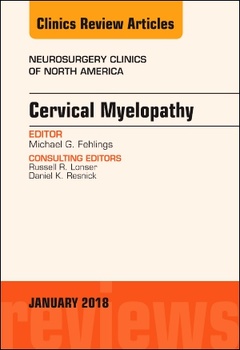Cervical Myelopathy, An Issue of Neurosurgery Clinics of North America The Clinics: Surgery Series
Auteurs : Fehlings Michael, Mizuno Junichi

Neurosurgery Clinics of North America
Cervical Myelopathy
Preface: Current Knowledge in Degenerative Cervical Myelopathy
Epidemiology and Overview of the Clinical Spectrum of Degenerative Cervical
Myelopathy
Pathobiology of Degenerative Cervical Myelopathy
The Natural History of Degenerative Cervical Myelopathy
Imaging Evaluation of Degenerative Cervical Myelopathy: Current State of the Art
and Future Directions
Pathophysiology of Calcification and Ossification of the Ligamentum Flavum in the Cervical Spine
Radiologic Evaluation of Ossification of the Posterior Longitudinal Ligament with Dural Ossification
Ossification of the Ligaments in the Cervical Spine, Including Ossification of the Anterior Longitudinal Ligament, Ossification of the Posterior Longitudinal Ligament, and Ossification of the Ligamentum Flavum
Importance of Sagittal Alignment of the Cervical Spine in the Management of
Degenerative Cervical Myelopathy
Anterior Cervical Option to Manage Degenerative Cervical Myelopathy
Laminectomy with or Without Fusion to Manage Degenerative Cervical Myelopathy
History and Evolution of Laminoplasty
Significant Predictors of Outcome Following Surgery for the Treatment of Degenerative Cervical Myelopathy: A Systematic Review of the Literature
Neurologic Complications in Managing Degenerative Cervical Myelopathy: Pathogenesis, Prevention, and Management
Options of Management of the Patient with Mild Degenerative Cervical Myelopathy
Management of the Patient with Cervical Cord Compression but no Evidence of
Myelopathy: What Should We do?
Clinical Characteristics and Management of C3-4 Degenerative Cervical Myelopathy
Intraoperative Neurophysiologic Monitoring for Degenerative Cervical Myelopathy
Health Economics and the Management of Degenerative Cervical Myelopathy
Managing the Complex Patient with Degenerative Cervical Myelopathy: How to Handle the Aging Spine, the Obese Patient, and Individuals with Medical Comorbidities
Future Directions and New Technologies for the Management of Degenerative Cervical Myelopathy
Date de parution : 12-2017



